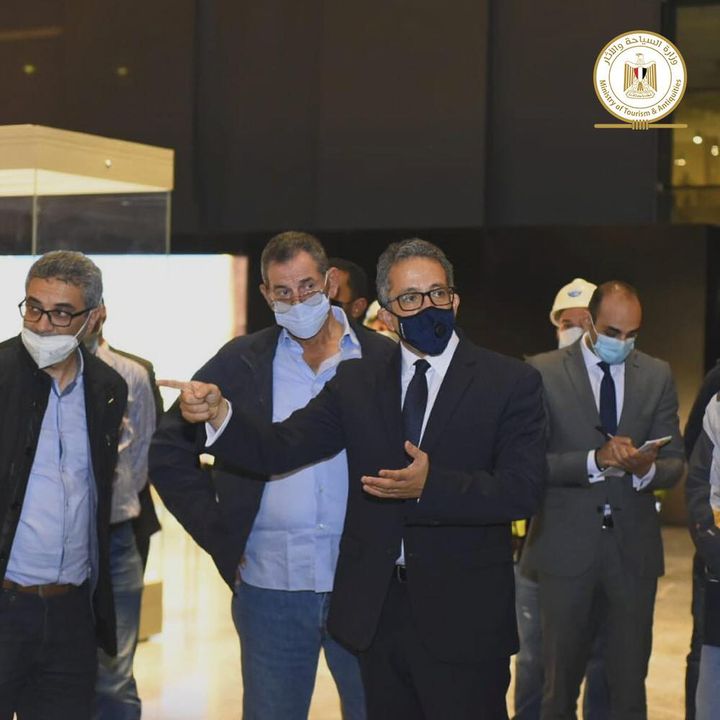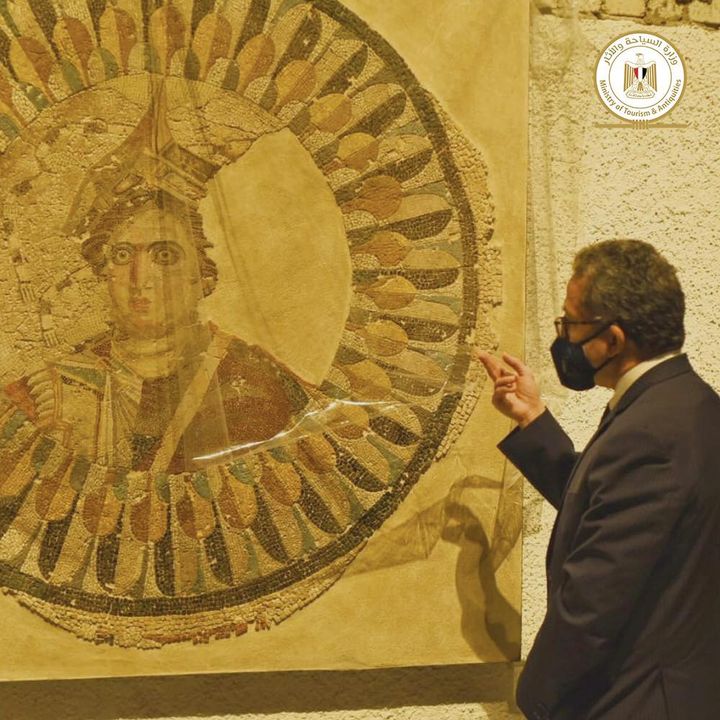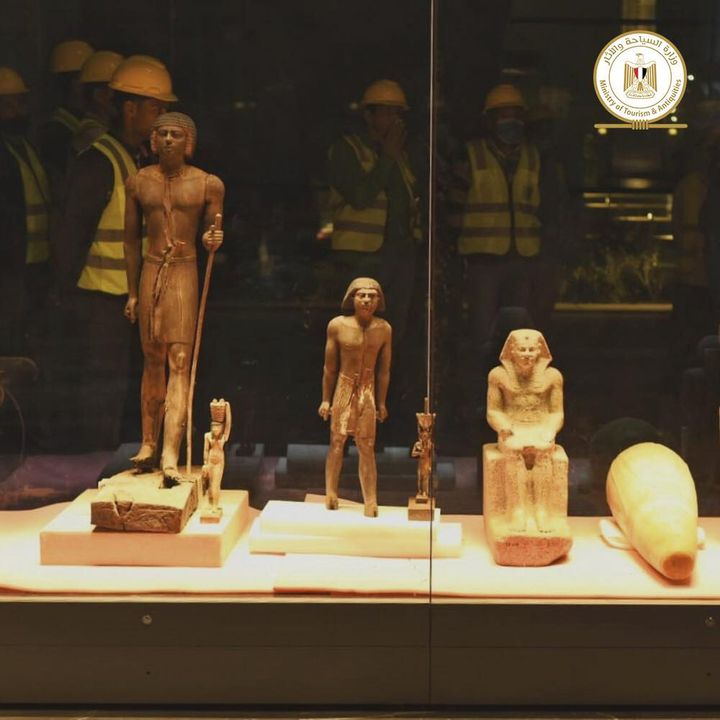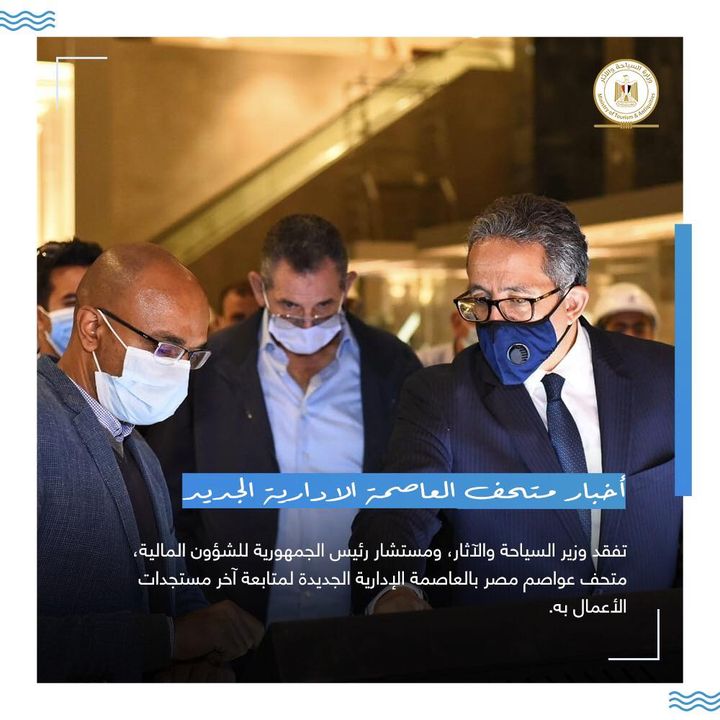وقد جاءت الزيارة للوقوف على سير الأعمال داخل المتحف، وما يتم من تجهيزات لعرض القطع الأثرية وفقا لسيناريو العرض المتحفي المخصص لها، حيث وجه وزير السياحة والآثار ببعض التغييرات في المحتوى الخاص بالكالتوراما ليتفق مع سيناريو العرض بالمتحف، كما وجه بتعديل أماكن عرض بعض القطع الأثرية ليتفق مع النسق التاريخي للعرض المتحفي وإثراءه.
وأكد د. خالد العناني على ضرورة الالتزام بالجدول الزمني المقرر مسبقا لانتهاء الأعمال استعدادا للافتتاح الوشيك للمتحف.
هذا وقد استقبل المتحف خلال الأيام القليلة الماضية عدد من القطع الأثرية؛ منها سجادتين إحداهما من الصوف عليها نص كتابي باللغة الفارسية يُقرأ: “صفازاره كاشان” وتتوسطها جامة باللون الأحمر والبيج. أما السجادة الثانية فعليها زخارف نباتية وهندسية بالألوان الكحلي والبرتقالي، يحدها من الجوانب شريطين، وساحة السجادة يتوسطها جامة مسننة ينبثق منها أشكال نباتية وهندسية. بالإضافة إلى قطع خزفية تحاكي أنماط الحياة اليومية من الزخارف والموتيفات عند المصري القديم، وتمثال نصفي من البرونز للخديوي إسماعيل، والتي تثري الجزء المخصص لعرض القاهرة الإسلامية والخديوية والحياة اليومية في هذه الحِقَب.
جدير بالذكر ان متحف عواصم مصر يروي تاريخ العواصم المصرية عبر العصور المختلفة، حيث يتكون من قاعة رئيسية يُعرض فيها آثار لعدد من عواصم مصر القديمة والحديثة يبلغ عددها 9 عواصم هم منف، طيبة، تل العمارنة، الإسكندرية، الفسطاط، القاهرة الفاطمية، مصر الحديثة، القاهرة الخديوية، هذا بالإضافة إلى عرض مجموعة من المقتنيات المختلفة التي تمثل أنماط الحياة فى كل حقبة تاريخية خاصة بكل عاصمة على حدة مثل أدوات الزينة، وأدوات الحرب والقتال، ونظام الحكم والمكاتبات المختلفة.
اما القسم الثاني من المتحف فهو عبارة عن جناح يمثل العالم الآخر عند المصري القديم، ويتكون هذا الجزء من مقبرة توتو التي تم اكتشافها عام 2018 بمحافظة سوهاج، بالإضافة إلى قاعة للمومياوات والتوابيت وفتارين تحتوي على الأواني الكانوبية ومجموعة من الأبواب الوهمية ورؤوس بديلة تحاكي الطقوس الدينية فى مصر القديمة.
وسيتضمن العرض المتحفي، استخدام التكنولوجيا الحديثة حيث تم تزويد قاعات العرض بشاشات تعرض فيلم بانورامي تفاعلي “المالتى ميديا” لعرض التاريخ ، صوتا وصورة ، وعرض توضيحي لشكل كل عاصمة من العواصم المصرية القديمة موضوع العرض وطبيعة العمارة السكينة والمباني الدينية بها وأشهر معالمها، لتضيف لمسة ابداعية جديدة ، تجذب الزائرين و السائحين.
Dr. Khaled El-Enany, Minister of Tourism and Antiquities, and Major General Mohamed Amin, Adviser to the President for Financial Affairs, visited the Museum of Egypt’s Capitals in the New Administrative Capital, to follow up on the progress of work there.
They were accompanied by Dr. Mostafa Waziry, Secretary General of the Supreme Council of Antiquities, and Dr. Ali Omar, Chairman of the Supreme Committee for Museum Display Scenario, Dr. Mahmoud Mabrouk, Adviser to the Minister for Museum Presentation and members of the Committee, Professor Moamen Othman, Head of Museums Sector, and Dr. Mona Raafat, general supervisor of the museum and officials of the ministry.
They saw the display cases of the artifacts and the Minister of Tourism and Antiquities directed the Committee for Museum Display Scenario to do some changes in the content to conform with the display scenario in the museum, and also to amend the places where some artifacts are displayed in accordance with the historical flow of the museum’s display to enrich it.
Dr. Khaled El-Enany stressed the need to adhere to the schedule set in advance for the completion of work in preparation for the imminent opening of the museum.
In the past few days, the museum has received a number of artifacts; among them are two carpets, one of them made of wool, with a Persian text that reads: “Svazarh Kashan” and in the middle of it is a red and beige jama. As for the second carpet, it has floral and geometric motifs in navy and orange colors, bordered on the sides by two bands, and the middle of the carpet has a serrated camel in the center, from which floral and geometric motifs emerge. In addition to ceramic pieces that simulate daily life from the decorations and motifs of ancient Egypt, and a bronze bust of Khedive Ismail, which enriches the section dedicated to displaying Islamic Cairo, Khedive and daily life in these eras.
It is worth noting that the Museum narrates the history of the Egyptian capitals through different eras, as it consists of a main hall in which the relics of a number of ancient and modern Egyptian capitals are displayed, numbering 9 capitals: Memphis, Thebes, Tell Amarna, Alexandria, Fustat, Fatimid Cairo, Modern Egypt, Khedivial Cairo, in addition to displaying a group of different holdings that represent the patterns of life in each historical period for each capital separately, such as decorative tools, war and fighting tools, the system of government and various correspondences.
As for the second section of the museum, it is a pavilion that represents the after life in ancient Egypt, and this part consists of the Tutu tomb that was discovered in 2018 in Sohag. In addition to a hall for mummies and coffins and showcases that contains canopic jars and a set of imaginary doors and alternate heads that simulate religious rituals in Ancient Egypt.
The museum’s display will use modern technology, where the exhibition galleries are equipped with screens displaying an interactive panoramic film showing the history, and an illustration of each of the ancient Egyptian capitals.





